Being a cat parent brings both joy and challenges. Cats seem independent and aloof, but they can learn fun tricks and behaviors with the right approach. This guide offers expert tips and techniques to help you train your cat successfully.
Whether you want to teach your cat basic commands, stop bad behaviors, or just get closer, this article has you covered. We’ll explore how to understand your cat’s behavior and use positive reinforcement. You’ll learn the key principles of cat training to reach your goals.
Key Takeaways
- Learn how to effectively train your cat using expert-recommended techniques
- Understand the benefits of training your feline friend and why it’s important
- Discover the power of positive reinforcement in shaping your cat’s behavior
- Explore the basics of litter box training and teaching your cat tricks
- Prevent unwanted behaviors and create a stimulating environment for your indoor cat
Introduction: Why Train Your Cat?
Training your cat might seem hard, but it has many benefits. As pet owners, we often overlook the value of teaching our cats good habits. But, putting time and effort into training can make a big difference in their happiness and our bond with them.
The Benefits of Training Your Feline Friend
Cat training helps with bad habits and keeps your pet’s mind sharp. Here are the main reasons why train your cat:
- Develops obedience and cooperation: Trained cats listen better to their owners, making them easier to handle.
- Prevents unwanted behaviors: Training can stop problems like scratching furniture or peeing where they shouldn’t.
- Promotes mental well-being: Learning new things keeps your cat’s mind busy and lowers stress and boredom.
- Strengthens the bond: Training with positive rewards builds a stronger connection with your cat.
- Enhances safety: Trained cats are quicker to respond in emergencies, reducing the risk of danger.
The reasons to train cat are clear, and the cat training benefits are big. By valuing importance of cat training, you open up new possibilities. This ensures your cat has a happier, healthier, and more joyful life.
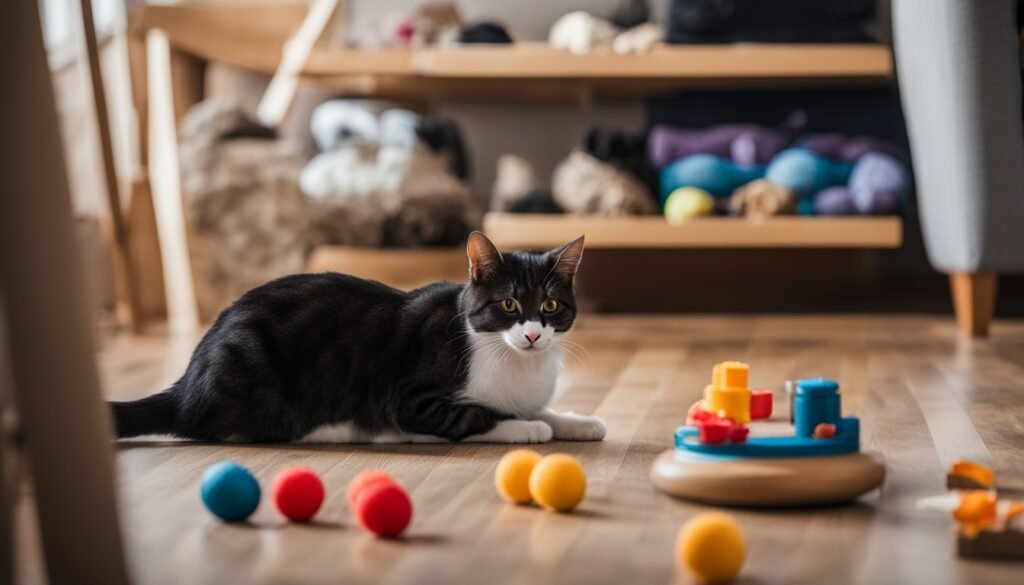
“The greatest pleasure of a dog is that you may make a fool of yourself with him, and not only will he not scold you, but he will make a fool of himself too.”
– Samuel Butler
Understanding Your Cat’s Behavior
As a cat owner, it’s key to know your cat’s special behaviors for good training. Exploring cat behavior, feline behavior, cat psychology, and cat communication helps you train better and connect more with your cat.
Cats are complex, and their body language tells a lot about how they feel. From paw kneading to tail twitching, each action means something. Learning to read these signs helps you meet your cat’s needs and know what they want.
It’s also vital to understand what your cat says with their sounds. From meows to growls, these sounds tell you how they feel inside. This lets you answer them right and make training positive.
| Common Feline Vocalizations | Meaning |
|---|---|
| Meow | Greeting, requesting attention, or expressing a need |
| Purr | Contentment, affection, or seeking attention |
| Growl | Aggression, fear, or discomfort |
| Hiss | Defensive or aggressive response to a perceived threat |
Knowing your cat’s behavioral patterns and how they communicate helps you meet their needs. It also helps you stop bad behaviors and make training positive. This knowledge is key to training your cat well.
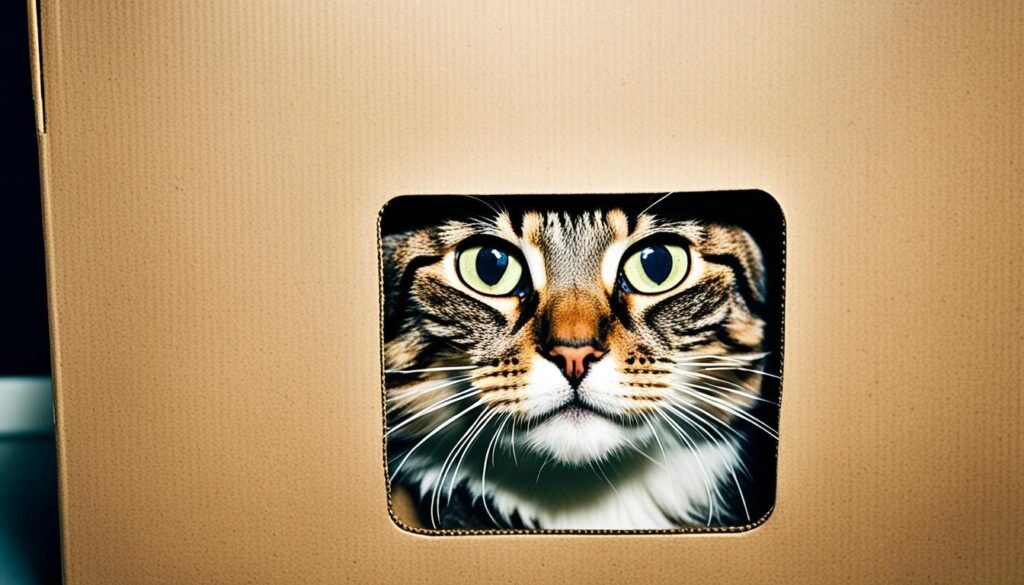
Positive Reinforcement: The Key to Successful Training
Training your cat with positive reinforcement is key. This method rewards good behaviors instead of punishing bad ones. It’s a humane and science-backed way to train your cat.
By using positive reinforcement, you’ll make training fun and successful. You’ll also strengthen your bond with your cat.
Treats, Praise, and Other Rewards
Positive reinforcement in cat training relies on treats, praise, and rewards. Cats love food, so cat training treats work well. When you give them a treat and praise, they’ll learn to do it again.
But treats aren’t the only reward. You can also use affection, playtime, or their favorite toys. Find out what your cat likes most to use during training.
- Use small, bite-sized cat training treats as rewards
- Pair treats with enthusiastic verbal praise to reinforce the behavior
- Experiment with other rewards like playtime, affection, or access to toys
Positive reinforcement makes your cat more eager to learn and behave better. It’s great for both you and your cat!

“Positive reinforcement is the foundation of successful reward-based cat training. It’s a game-changer for building a strong bond with your cat and helping them learn in a stress-free, enjoyable way.”
Train Cat: The Basics of Litter Box Training
Learning how to use the litter box is key for cat owners. It keeps your home clean and peaceful. I’ll show you how to train your cat step by step, making it easy for them to use the cat litter box.
Start by picking the right cat litter box. Think about size, shape, and material to make sure your cat likes it. Let your cat get used to the litter box slowly, letting them sniff and explore it.
- Put the litter box in a quiet spot that’s easy for your cat to get to.
- Help your cat use the litter box by guiding them there after meals, naps, and play.
- Give your cat treats and praise when they use the litter box, making it a good thing.
Dealing with litter box problems like not using it or accidents is important. Talk to a vet or a trainer to find out why and fix it. This will make things easier for you and your cat.
| Litter Box Type | Recommended for | Advantages |
|---|---|---|
| Open Litter Box | Cats who prefer easy access | Affordable, easy to clean |
| Covered Litter Box | Cats who prefer privacy | Helps contain odors, provides a sense of security |
| Self-Cleaning Litter Box | Busy pet owners | Reduces maintenance, promotes cleanliness |
Follow these tips and solve any problems that come up. You’ll get good at litter box training and make a happy home for you and your cat.
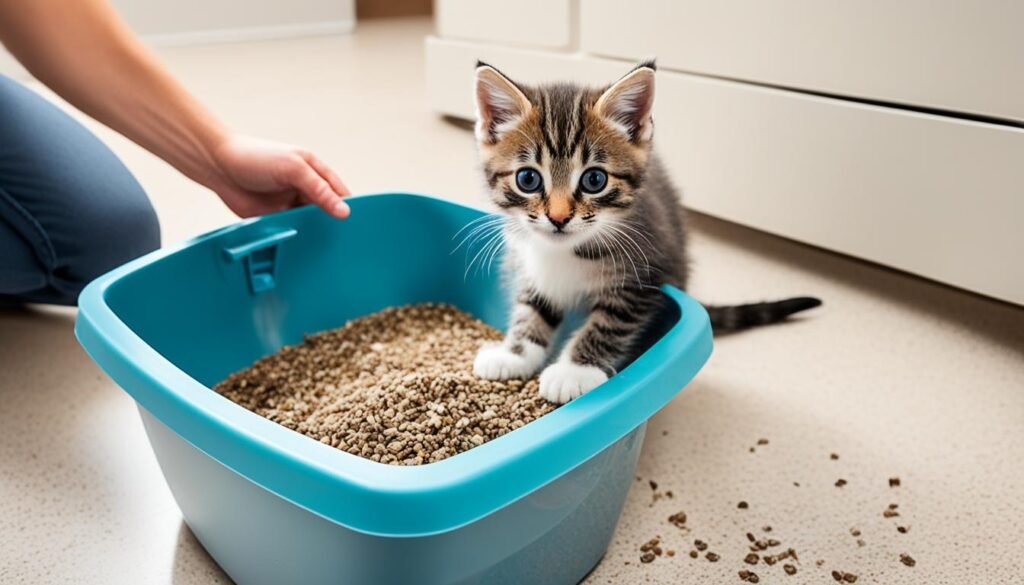
“Successful cat housebreaking is not about punishing your cat, but rather about providing the right environment and positive reinforcement to encourage the desired behavior.”
Teaching Your Cat Tricks
Cats are very smart and can learn new things. Teaching them tricks can be fun and make your bond stronger. We’ll look at how to teach your cat basic commands like “sit,” “stay,” and “come.”
Mastering Sit, Stay, and Come Commands
Positive reinforcement and patience are key to training your cat. Start with the “sit” command and give them a treat or praise when they sit. Then, move to “stay” by increasing the time and distance before you reward them.
The “come” command is important for your cat’s safety. Call their name and give a treat when they come to you. Slowly increase the distance over time. Always end training on a positive note to strengthen your bond.
| Trick | Steps | Rewards |
|---|---|---|
| Sit |
|
Treats, verbal praise |
| Stay |
|
Treats, verbal praise |
| Come |
|
Treats, verbal praise |
Every cat learns at their own speed, so be patient. Celebrate their small wins. With consistent practice and positive reinforcement, your cat will learn new tricks and commands.

Preventing Unwanted Behaviors
Owning a cat can be rewarding but challenging. Training your cat helps with good behaviors. It’s also key to stop bad actions. We’ll look at ways to handle common problems, making life better for you and your cat.
Many pet owners deal with unwanted scratching. Cats need to scratch. Give them a sturdy scratching post or pad in your home. Give treats and praise when they use these spots, and gently stop them from scratching furniture.
Too much meowing can be tough. It might be from boredom, stress, or wanting attention. Make sure your cat has toys, perches, and playtime. If it still meows a lot, see a vet to check for health problems.
Aggression towards people or pets is hard to manage. It can come from fear, stress, or feeling threatened. Give your cat a safe spot and introduce new people or animals slowly. Positive training can help reduce aggression.
“The key to preventing unwanted behaviors is to understand the underlying causes and proactively address them. With patience, consistency, and the right strategies, you can create a harmonious home for both you and your feline friend.”
By tackling these issues and using proactive methods, you can stop cat behavior problems, curb cat behavior issues, and eliminate unwanted cat behaviors. Remember, each cat is different. Working with a vet or trainer can help you find the best way for your cat.

Clicker Training: A Modern Approach
Clicker training is a modern way for cat owners and trainers to connect. It’s based on science and lets you talk to your cat clearly. This method helps your cat learn faster and builds a stronger bond. By learning clicker training, you can teach your cat new tricks and commands.
How to Use a Clicker Effectively
Knowing how to use a clicker is key to clicker training. Here’s a simple guide to start:
- Introduce the Clicker: Let your cat get used to the clicker sound. Click it and then give a treat right away to link the sound with something good.
- Mark the Desired Behavior: When your cat does what you want, like sitting or coming when called, click and give a treat.
- Practice, Practice, Practice: Keep clicking and treating until your cat gets the sound-reward link. Then, make the behaviors you’re training harder.
- Be Consistent: Keep your training routine the same and click at the exact moment your cat does the right thing. This helps them know what you want.
By following these steps, you can use clicker training cats to teach them new tricks and commands. With patience and hard work, you’ll have a stronger bond and a better-behaved cat.
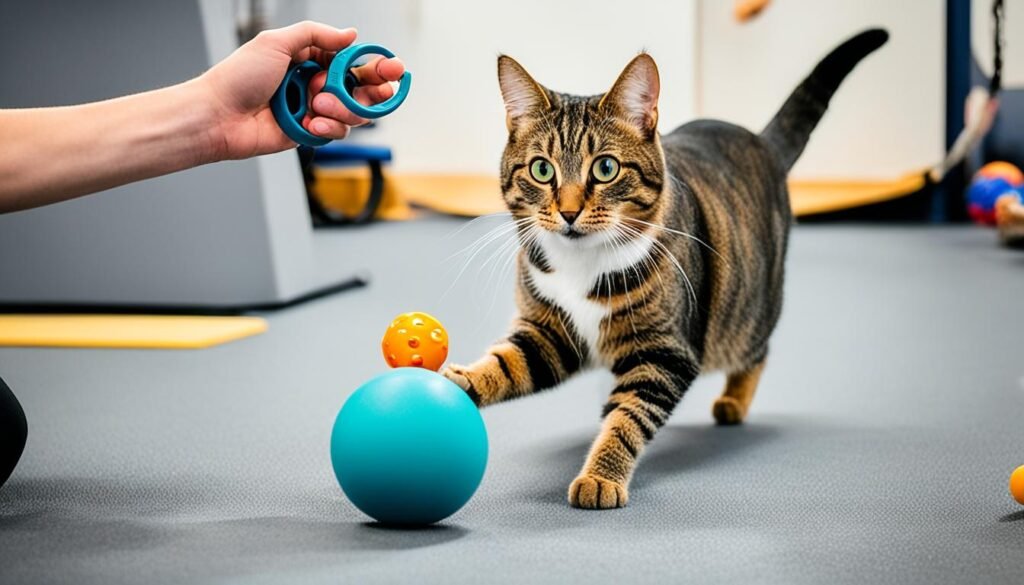
“Clicker training is a game-changer for cat owners. It allows you to communicate with your cat in a way they understand, leading to faster learning and a deeper connection.”
Socializing Your Cat with People and Other Pets
As a cat owner, making sure your cat gets along with people and other pets is key. It helps your cat feel at ease and builds a peaceful home. We’ll share tips on how to introduce your cat to new people and animals in a way that works for everyone.
Introducing Cats to People
When socializing your cat with people, go slow and be patient. Let them watch new people from a safe spot at first. Give them treats and praise when they act friendly, but don’t push them if they’re not ready.
With time and positive feedback, your cat will start to trust and like being around new people.
Integrating Cats with Other Pets
Meeting other pets, like dogs or cats, needs extra care. Start by letting your cat get used to the new pet’s smell through shared bedding or toys. Watch their first meetings in a neutral area, ready to step in if needed.
Being patient and rewarding good behavior helps your cat feel safe and happy with new friends.
Every cat is different, so know what makes your cat special. Provide a loving and supportive space for them to meet people and pets. With patience, consistency, and effort, your cat can become a happy and confident part of your family.
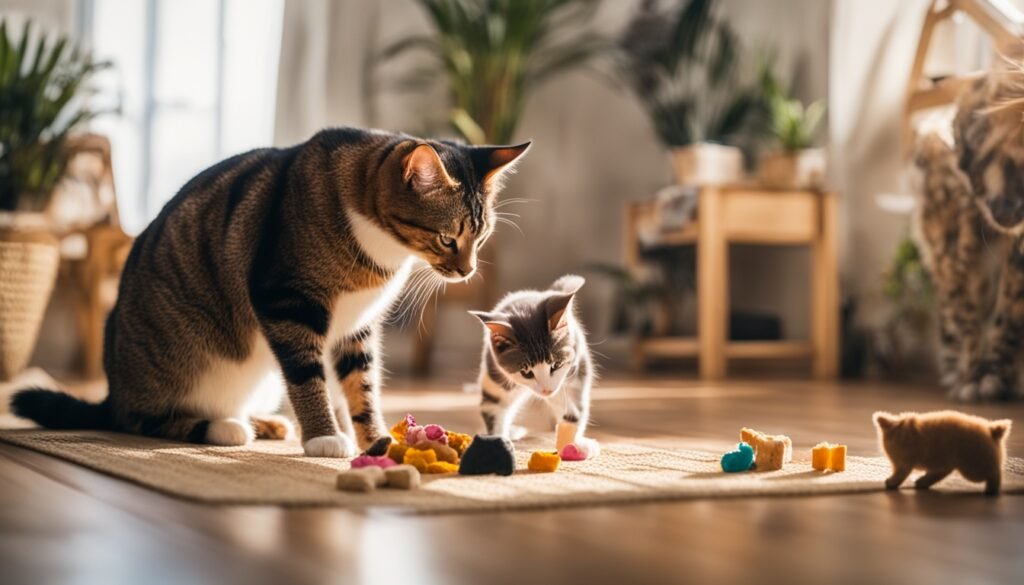
“Socialization is crucial for a cat’s well-being and can lead to a happier, more well-adjusted pet.”
Creating a Stimulating Environment
To help your cat learn and stay happy, it’s key to make their space engaging. As a cat care expert, I’ve seen how cat enrichment activities boost their life quality. They also help with the training you’re doing.
Interactive cat toys are great for keeping your indoor cat busy. Puzzle feeders, toys with treats inside, and electronic mice make them think and hunt. This keeps them active and interested. Changing the toys often stops them from getting bored.
For cat mental stimulation, make sure they have places to play and explore. Set up areas with tall scratching posts, cat trees, and places to hide. This encourages them to climb, scratch, and act naturally. Playing with wand toys or laser pointers also helps them use their energy and brings you closer.



